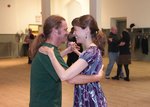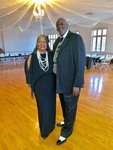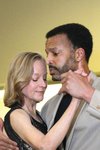Most people take dance classes for a fun cardio workout and a great way to expand their social horizons. But scientists say they offer even more benefits.
This item is available in full to subscribers.
We have recently launched a new and improved website. To continue reading, you will need to either log into your subscriber account, or purchase a new subscription.
If you are a digital subscriber with an active subscription, then you already have an account here. Just reset your password if you've not yet logged in to your account on this new site.
If you are a current print subscriber, you can set up a free website account by clicking here.
Otherwise, click here to view your options for subscribing.
Please log in to continue |



Most people take dance classes for a fun cardio workout and a great way to expand their social horizons. But a recent study published last month in the Journal of Aging and Physical Activity found an even better reason. Taking a ballroom dance class has been proven to reduce memory loss and dementia.
The study compared two groups of adults over 65 for six months. One group attended twice-weekly ballroom dance classes; the other group took treadmill classes. The results found that, while both groups improved their “executive function,” which includes planning and reasoning, the ballroom dancers generated significantly greater cognitive improvements than those on treadmills. Dancing was linked to reduced brain atrophy in the hippocampus – the part of the brain that can grow neurons. This means that dancing doesn’t just prevent brain cells from dying; it may generate new ones.
Explore area dance classes
Fortunately, there are an abundance of ballroom and other dance classes in the Northwest. Whether you have a partner or not, want to sign up for several sessions or just attend an occasional class, you can find an opportunity to improve your memory and mood through dance without leaving the neighborhood.
“Dancing works with muscle memory so it’s a workout for your memory,” said Debra Klinger who has been teaching ballroom dance at Mt. Airy Learning Tree (MALT) for 29 years. Klinger teaches three classes: Beginner Ballroom, Beyond Beginner and Intermediate Ballroom on Thursday evenings at Chestnut Hill Presbyterian Church, 8855 Germantown Ave.
“In the beginner class, we cover the basics: foxtrot, waltz, rumba and swing,” Klinger said. “The next level adds more dances according to students’ preferences, such as tango. On the intermediate level, I give participants a choice of twelve dances and they pick their favorite two. This season, I am focusing on cha cha.”
Klinger teaches social style dancing, not the formal international style used in competitions. “I recommend a slight turn of the head to the left for followers in the traveling dances, like the waltz and the foxtrot, where the leader needs to focus on where they are moving and the goal is to move as one unit with your partner,” she said. “However, I encourage eye contact for the rhythmic dances, like rumba and swing, where you dance in one space more or less and can focus more on interacting with your partner.”
Klinger has noticed a renewed enthusiasm for dance classes following the isolation of the pandemic. She has also made changes to the way she teaches as a result of COVID, she said.
“People appreciate life more,” she said. “However, I am sticking with precautions. I require masks and smaller class sizes. Plus, participants do not change partners.”
Ready to learn Argentine tango? Instructors Adam Biggs, a history professor, and Ann Kent, a former ballet instructor, are ready to show you how it is done at Chestnut Hill Presbyterian Church, starting Thursday, Feb. 9 at 7 p.m.
The romance of tango proved true for Biggs and Kent, who met 15 years ago at a tango dance class.
“I had never done any kind of dancing before but I was a Division One basketball player and was looking for an opportunity to socialize,” Biggs said. “I saw a tango class through a window, and it looked so nice I came back.”
Biggs and Kent eventually became competition tango dancers and instructors.
“We became frustrated with the way tango was taught, with an emphasis on steps and technique,” Kent said. “We saw people focusing on steps and technique, and people spent a lot of time trying to perfect a particular move. Those are things that are appropriate for competitive dancing. We are more focused on social dancing, on how you interact with your partner.”
No partner? No problem at MALT’s Everybody Can Line Dance classes at Summit Presbyterian Church, 6757 Greene St., where classes meet on Wednesdays starting Feb 15. Beginners class starts at 6:30 p.m. and classes for people with more experience start at 7:45 p.m. Instructors Audrey and James “June” Donaldson have also taught dance at Chestnut Hill Friends Meeting, the Waldorf School, Christ Ascension Lutheran Church and on the campus of New Covenant Church in Mt. Airy.
Prefer a daytime class? Attend a Classic Soul Line Dance Party hosted by the Donaldsons with a guest instructor on the third Saturday of the month, 11 a.m. to 4 p.m. at the Venetian Club in Chestnut Hill, 8030 Germantown Ave.
Another class where partners are not required is the Salsa and Bachata lessons at Jacob’s Northwest, 7165 Germantown, every other Wednesday. Class starts at 7 p.m. and is followed by a dance party.
If you want to learn the Philly Bop, a form of swing that evolved from the Lindy Hop in the 1950s and Detroit Smooth Ballroom (also known as the Strand) come to Treasures, 5549 Germantown Ave. on Thursdays at 5:30 p.m. After the lesson, which is taught by the Donaldsons, stay for an oldies dance party.
While the 2022 study linking dance classes to improved brain function focused specifically on ballroom dance classes, other studies have shown that all forms of social dance have a positive impact on the brain. Another 2022 study published in Complementary Therapies in Clinical Practice found that even free-flowing, unstructured dance has physical and mental health benefits. The secret is to constantly learn new steps and advance your skills.
For more information: visit mtairylearningtree.org or call 215-843-6333 for MALT classes; visit dancinginphilly.com or call 610-368-7043 for classes with the Donaldsons and visit jacobsnorthwestphl.com for the restaurant’s salsa lessons.